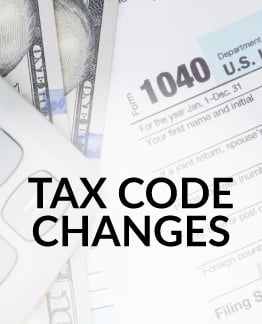
This is the first entry in a five-part series of articles about changes to the U.S. tax code from the Tax Cuts and Jobs Act. Topics of the upcoming articles include mortgage interest deductions, miscellaneous itemized deductions, the Alternative Minimum Tax, and qualified business income.
The Tax Cuts and Jobs Act (TCJA) produced significant changes to the U.S. tax code. Though the regulations implementing the code still are being written, we do know some details.
Itemized Deductions
The tax code allows you to elect to take a standard deduction of a set amount. In 2017, that amount was $12,700 for those married filing jointly (MFJ). For single taxpayers, the amount was $6,350, and for head of household (HoH), the amount was $9,350. For 2018, the amounts increased to $24,000 for MFJ, $12,000 for single taxpayers, and $18,000 for HoH. This means that for more taxpayers, the standard deduction will be larger than the amount they can claim if they itemize.
But you should look a little deeper. If your state has an income tax, it might not be so simple. Most states pull a number from some point on the federal tax return. Many use adjusted gross income (AGI), and those that do normally allow you to itemize or take a state standard deduction. In many cases, if you take the standard deduction on your federal return, you must take the standard deduction on your state return.
Therein lies the rub: Most states' standard deduction is significantly less than the new standard deduction on the federal return. If your actual deductions are close to your federal standard deduction, you might want to elect to itemize even though you'll pay more in federal taxes to get the larger deduction on your state return and pay less in state taxes. To know for sure, you'll need to calculate your taxes both ways.
Exemptions
Exemptions are eliminated under the TCJA. You still will want to determine whether your children or others are dependents, though, because certain credits, such as education credits and child care credits, depend on status as a dependent. Also, the states didn't sign onto this, so you might still have exemptions on state returns.
Child and Dependent Credits
The TCJA significantly expanded the child credit and added a new credit for dependents. Under the TCJA, the child credit is increased to $2,000 per child from the current credit of $1,000. But perhaps even more important for those in a post-military career, the AGI limit for the credit is increased to $400,000 for MFJ and $200,000 for all others. This will open up the credit to a lot more taxpayers.
The child credit is limited to children under age 17. This is true in both the “old” tax law and the TCJA. But the TCJA added an additional credit that could apply to your children (and your parents). The dependent credit is $500 and applies to dependents who are not qualifying children. In other words, if you child is in college and qualifies as a dependent, you can claim the $500 credit.
